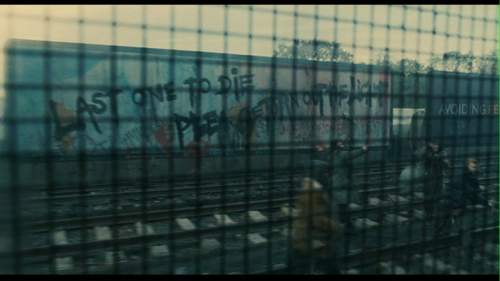Shantih shantih shantih
by johangardebo
If juxtaposing the two authors’ work, T S Elliot’s The Waste Land and P D James’ The Children of Men, the former is a retained version of the latter. True to Hagakure, putting ten words into one, Elliot’s poem would have, if unpacked, looked very much like James’ drama about humanity’s end of days by mass infertility. This barren wasteland, set in England 2021, twenty-five years after the last child was born, depicts a society set on short-term goals and longing for golden ages past. Elliot himself could even have played the main character, Oxford don Theo Fallon, who privileged, educated and detached eventually set roots, heart and hope in the wasteland.

While Elliot wrote The Waste Land following World War 1, the environmental critique continued, even after the trenches had been covered over and the rains had washed the toxics from the land. That wasteland is still beneath us but also lies up ahead. As a reading of the Anthropocene, The Waste Land is not an ode to the past, but an attempt to cope continuously with things which once lost are irretrievable.
He who was living is now dead
We who were living are now dying
With a little patience
Elliot struggled to make real what seemed unreal; the Falling Towers (Jerusalem, Athens, Alexandria, Vienna, London).
James’ The Children of Men play on the fall of the civilization through the changed space of society. While the authorities plan to concentrate populations, power and produce to the cities, under the administration of the “Warden of England” (isn’t that a great title?), many react by fleeing to the woods, going rouge with face-paintings and torches, or stockpiling food. Theo did the same except his home was filled with literature, the reality of the past as a cushion against the unreality of the future (in fifty years time without any humans in it). The tragedy here is not the range of imagined horrors to come but the limitations imposed by real horrors ever-present:
She (Julian) and Miriam were in the back drowning and there was nothing he could do to help. Sweat broke out on his forehead and, clenching his wet palms, he forced his eyes from the horror of the lake and looked up at the sky, wrenching his mind from imagined horror back to the horror of normality. The sun was pale and round as a full moon but blazing with light in its aureole of mist, the high boughs of the trees black against its dazzle. He closed his eyes and waited. The horror passed and he was able to look down again at the surface of the lake.
How to explain why Theo, Julian and Miriam are better off at the lake-side than on the lake-bottom when all will be over for humanity in a foreseeable future? More than any societal upheaval, class of civilisations or economic systems, the end of history becomes a psychological dilemma by the simple reason that humans no longer can reproduce. Theo Fallon perhaps more than anyone is pissed at how things turned out. As a historian, the death of theological time takes the fun out of any history, what is in indeed the point? The psalm rings true, “You return man to dust and say, ‘Return, O children of man! (King James Bible, 90:3)’ but none is there to say the words.
The environmental narrative comes out even stronger in the movie adaptation Children of Men (2006) and has been analysed in relation to climate change repeatedly, most recently by Dougald Hine. The movie’s story is one about faith and change. Faith bring us to places, chance can bring us together in those places. By chance, hope is lost, and through lingering faith hope can be regained, if by chance the occasion presents itself. Through a similar line of reasoning, the environmental critic Rob Nixon said that “humans in the Anthropocene do not need hope but faith” (Tales From Planet Earth, Stockholm 2014).

With The Waste Land putting ten words into one, The Children of Men added so much more to a narrative that cannot be described only as an environmental critique. It is about a Christian worldviews, of self-righteous lamentations and the confusion both of having no children and growing up as lonely children, in lonely houses. The book digress to deliver these points and does it equally artfully and ordinarily than both the poem and the movie adaptation (and make no mistake, I love that movie to death). The Anthropocene is at the edges of the pages, hidden in the leaves of the forests through which Theo and the last of the humans are passing. While my 2016 is, like James’ 2021, a time of mass extinction, the warning bells are primarily the death of other species, not ours. The children of men is not yet dead, but already is returning to dust many of its companion species.
The Children of Men and The Waste Land are artful because they never answer the question why? Why is it that we cannot make babies anymore? Why is the world turned barren? And why would the coming of Alpha make right what by the Omega, the end of time, had gone astray?
Carl looked down at the child with his dying eyes and spoke his Nunc Dimittis. “So it begins again.” Theo thought: It begins again, with jealousy, with treachery, with violence, with murder, with this ring on my finger.
‘Why’ is the salient but less important aspect of The Children of Men. The ending parallell to the Anthropocene and ‘why’ the climate is changing challenge us to think of not only what things are ending, but what could be there at the beginning. How would we begin to formulate what the world should be like if we steer clear of extinction? What would be different about life if we learned how to die?